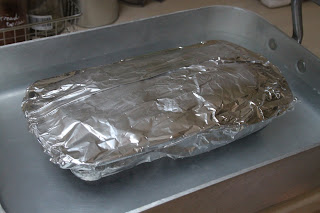So when a friend invited us to some house warming drinks, I immediately thought Terrine de Campagne. Rustic, warming with the promise of perfectly chilled champagne, there was no doubt that this was the dish of choice.
It’s a simple dish, uncomplicated despite being made in two stages. The first is the preparation of the ingredients that then sit overnight and the second is the cooking and the eating!
Served with bread, cornichons (those crisp, tart pickles), and some chutney, it’s a perfect dish that lasts up to a week.
Terrine de Campagne is a basic of the French kitchen, as you can see from every charcuterie and market that you visit. Everyone has a different recipe but the fundamentals remain the same – a earthly terrine with a depth of flavour, using local ingredients.
Where to begin
250g sliced bacon
a tablespoon of butter
1 onion, chopped
500g pork minced
250g veal, minced
250g chicken livers, finely chopped
2 cloves garlic, finely chopped
¼ teaspoon ground allspice
A pinch ground cloves
A pinch ground nutmeg
2 small eggs, beaten
2 tablespoons of cognac (the original recipe called for brandy)
salt and pepper to season
bay leaf
sprig of thyme
If you are feeling adventurous you could add pistachio nuts OR just jump right in there and include some preserved truffles. This I had intended to do but forgot! This is despite the fact that I had prepared all the recipes in advance.
Before moving onto the cooking process – the question of the terrine dish needs to be explored.
My desire to make a terrain came from my first visit to E. Dehillerin, that Aladdin’s cave of culinary wonderment, where I found in the basement, cast iron Chasseur dishes. I was sold except there was no way that I could cart home a terrine dish on the Eurostar. I would get one in London at the sales I told myself.
Well of course I didn’t, so when preparing to make this terrain I also looked at purchasing a terrine dish. Ummh, who would have thought they were so (and I mean so so) expensive. Seriously! So I used a cake tin instead – perfectly acceptable, especially when one has a petite kitchen, where space needs to be bartered for!
So let’s get to the cooking.
Preparation
Start by lining your terrine dish (or in my case, a cake tin) with bacon. Make sure that you retain a few slices that will be used to cover the terrain at the end of this first stage.

Now a quick word about my ingredients. The pork and livers came from my favourite butcher. The pork was minced; the livers were not. So be prepared to dice your livers -very roughly. A much less queasy experience that I had imagined. Now the veal proved more troublesome as my butcher does not do veal, presumably for ethnical reasons. I'm not sure; so, I ended up getting veal from Waitrose. Perfectly acceptable.


Cooking of the terrine
Set the oven to 180ºC (35OºF).
Now here I departed from my original recipe and turned to Julia Child, that original domestic goodness, who understood that careful instructions are needed for those women without domestic help!
So to cook this is what you need: aluminium foil to cover the terrine, a heavy lid (that I will explain in a moment), and a pan of boiling water.
Cover the terrine dish in aluminium foil and place in a pan of boiling water. The water needs to come half-way up the pan. I used a heavy roasting dish.
Place the terrine in the lower third of the pre-heated oven and bake for 1.5 hours.
Julia recommends that the terrine is done when it has shrunk slightly from the dish. This it did and that the juices were clear. Now this is where I got confused. The side juices were clear but the middle juices were slightly pink.
Post-cooking and checking of juices, remove the terrine from the water and remove the foil. This is the stage, where you need to weigh down the terrain. All very easy: a cake tin, some cans and when it’s completely cool, put it in the fridge.







No comments:
Post a Comment